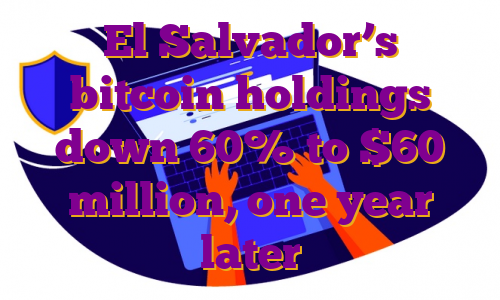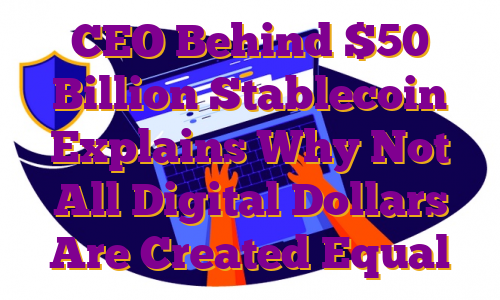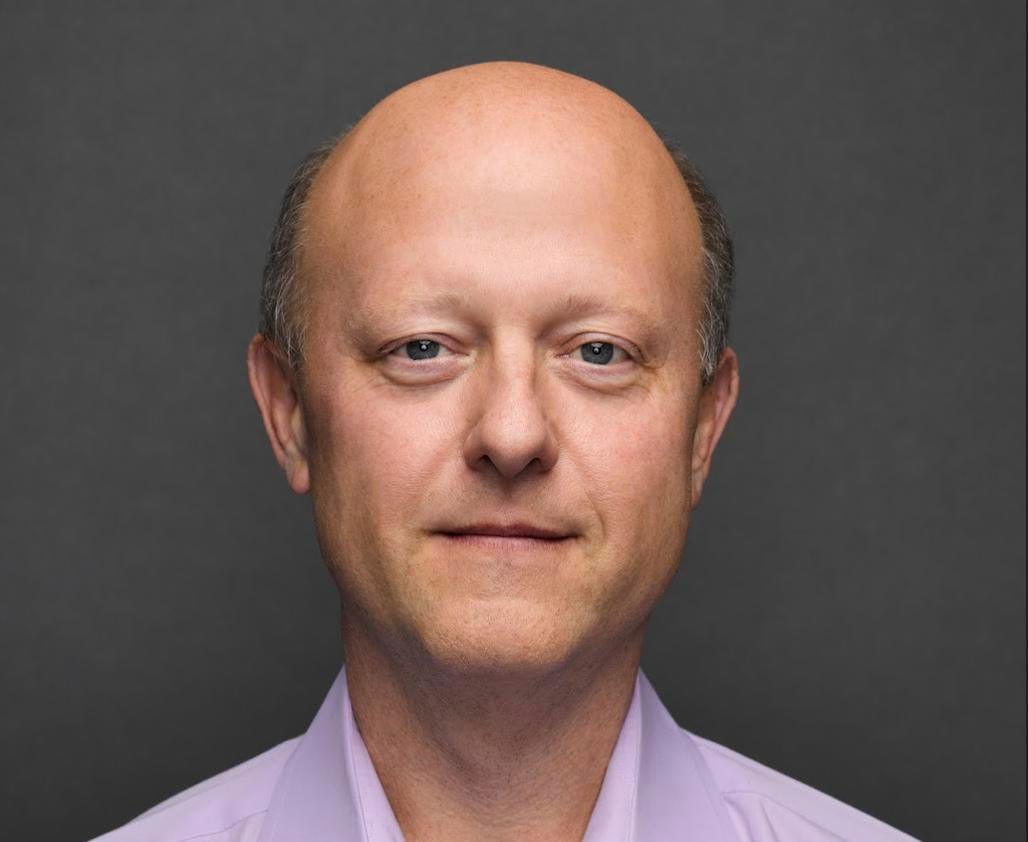Salvadoran President, Nayib Bukele speaks during an event in May 2021. El Salvador become the first country to adopt bitcoin as legal tender in June.Camilo Freedman | SOPA Images | LightRocket | Getty ImagesIt has been more than a year since El Salvador made history by becoming the first country to make bitcoin legal tender, and so far, 37-year-old resident Edgardo Acevedo has found the nationwide crypto experiment to be relatively anticlimactic.”I don’t think anything has changed, except that the country is more recognized than before, but the economic life of Salvadorans remains the same or worse than a few years ago,” said Acevedo, a development engineer working in the capital city of San Salvador.Acevedo, who is also known by the pseudonym Ishi Kawa, tells CNBC that while bitcoin has become a topic of conversation, adoption remains low, and he has personally found that there are very few businesses that accept the world’s biggest cryptocurrency — and even fewer Salvadorans who wish to pay in the digital token.”What has improved is the issue of violence and crime, but economically, I can say that nothing has changed,” he said.It has been a rocky time, with the project not living up to the grand promises made by the country’s popular and outspoken president Nayib Bukele.The use of bitcoin in El Salvador appears to be low, as the currency has lost about 60% of its value since the experiment started and the country still faces plummeting economic growth and a high deficit. El Salvador’s debt-to-GDP ratio — a key metric used to compare what a country owes with what it generates — is set to hit nearly 87% this year, stoking fears that the nation isn’t equipped to settle its loan obligations.Data from Bloomberg Economics shows that El Salvador tops its ranking of emerging market countries that are vulnerable to a debt default. Even as it retires some of its outstanding debts, the country’s domestic and multilateral loan obligations pose a real threat, in part because the world’s biggest lenders aren’t too keen to give cash to a country betting its future on one of the most volatile assets on the planet.Pair these economic woes with a renewed war on gang violence and the country is barreling toward uncertainty.”The government claims the developments as a success, but most local commentators and international watchers are underwhelmed,” Rachel Ziemba, founder of Ziemba Insights, told CNBC.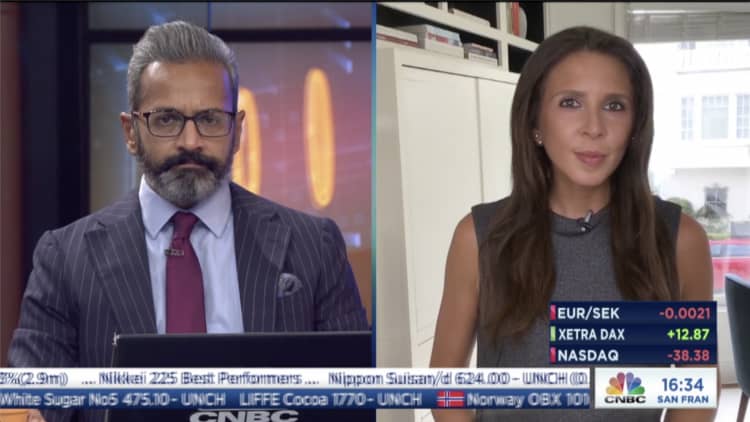 Bitcoin uptake appears lowWhen El Salvador’s Bitcoin Law came into effect Sept. 7, 2021, Jaime Garcia was hopeful that it would fix a few big problems with the way that Salvadorans send, receive and spend money.As part of the law, prices are now sometimes listed in bitcoin, tax contributions can be paid with the digital currency, and exchanges in bitcoin will not be subject to capital gains tax. But crucially, Bukele promoted the law as a way to expand financial inclusion — which is no small thing for a country where approximately 70% of the population does not have access to traditional financial services, according to the Bitcoin Law.To help facilitate national adoption, El Salvador launched a virtual wallet called “chivo” (Salvadoran slang for “cool”) that offers no-fee transactions, allows for quick cross-border payments, and requires only a mobile phone plus an internet connection. It aimed to bring users onboard quickly, both to scale bitcoin adoption and to offer a convenient onramp for those who had never been a part of the banking system.Bukele tweeted in January that about 60% of the population, or 4 million people, used the chivo app, and more Salvadorans have chivo wallets than traditional bank accounts, according to a Sept. 20 research note from Deutsche Bank. Still, only 64.6% of the country has access to a mobile phone with internet, that note says.But a report published in April by the U.S. National Bureau of Economic Research showed that only 20% of those who downloaded the wallet continued to use it after spending the $30 bonus. The research was based upon a “nationally representative survey” involving 1,800 households.Garcia, who lives in the Canadian province of Saskatchewan, fled El Salvador when he was 11 after rebels bombed his house, but he keeps in close touch with family and friends who stayed behind — and he sometimes sends money back home, too.”There are pockets where bitcoin is popular, like in El Zonte, but it’s clear that adoption is not massive,” said Garcia.”Big chains like McDonald’s, Starbucks, and most merchants at a mall will accept bitcoin — but are people using it? Not too much locally,” he said. “It’s mostly tourists using bitcoin.”A survey by the El Salvador-based El Instituto de Opinion Publica, a public opinion think tank, found that 7 in 10 Salvadorans do not think the Bitcoin Law has benefited their family economy.Another survey by the institute found that 76 out of 100 small and medium-size enterprises in El Salvador do not accept bitcoin payments.”Bitcoin’s first year in effect has transcended from a commercial expectation to an irrelevant topic for traders,” said Laura Andrade, director of El Salvador’s Universidad Centroamericana, according to a CNBC translation of her Spanish-language comments.Andrade said many large corporations are still advertising that they’re taking payments in bitcoin but are making excuses to not accept the cryptocurrency including saying their system does not work or the bitcoin wallet is out of service.”The foregoing is evidence that this cryptocurrency, in reality, never had penetration in national commerce,” Andrade said.”There seems to be evidence that most people used it primarily to get the free money from the government but have not used it on an ongoing basis given volatility and fees,” Ziemba said.Meanwhile, those who did use the government’s crypto wallet reportedly had technical problems with the app. Other Salvadorans fell prey to schemes involving identity theft, in which hackers used their national ID number to open a chivo e-wallet, in order to claim the free $30 worth of bitcoin offered by the government as an incentive to join.A survey published in March by the Chamber of Commerce and Industry of El Salvador found that 86% of businesses have never made a sale in bitcoin, and only 20% of businesses take bitcoin, despite the Law’s mandate that all merchants accept the cryptocurrency.”They gave people the wallets, they forced businesses to accept them, but essentially, in my opinion, it’s a big nothing burger,” said Frank Muci, a policy fellow at the London School of Economics, who has experience advising governments in Latin America. “Nobody really uses the app to pay in bitcoin. People that do use it, mostly use it for dollars.”The experiment also involved building a nationwide infrastructure of bitcoin ATMs, but they’re too far away for many people to use.Another hope for the chivo wallet was that it would help save hundreds of millions of dollars in remittance fees. Remittances, or money sent home by migrants, account for more than 20% of El Salvador’s gross domestic product, and some households receive over 60% of their income from this source alone. Incumbent services can charge 10% or more in fees for those international transfers, which can sometimes take days to arrive and require a physical pickup.But in 2022, recent data shows that only 1.6% of remittances were sent to El Salvador via digital wallets. According to the Deutsche Bank report from September, part of the reason bitcoin transfers haven’t caught on has to do with the complications of buying and selling bitcoin for dollars. The report notes that “people who send and receive remittances frequently use informal brokers to convert local currency to and from bitcoin” and extremely volatile prices make buying and selling the cryptocurrency a complex task requiring technical know-how.”This is a new money, a new way of doing things for a population that is very comfortable with dollars. This is a population that is largely unbanked and would rather deal with hard cash that they can see and feel,” Garcia said.Miles Suter, the crypto product lead at Cash App, told CNBC on a panel at the Messari Mainnet conference in New York that the government’s 90-day rollout of the chivo wallet and nationwide adoption of bitcoin was “rushed” and that there are still a lot of problems.”You shouldn’t mandate the acceptance of a specific currency,” said Suter, who spent six months in El Salvador in the runup to the passing of the Bitcoin Law. However, Suter added that the media perception is worse than how things are actually going on the ground.”I saw and experienced lives being changed by having access to a new emerging monetary standard,” he said.
Bitcoin uptake appears lowWhen El Salvador’s Bitcoin Law came into effect Sept. 7, 2021, Jaime Garcia was hopeful that it would fix a few big problems with the way that Salvadorans send, receive and spend money.As part of the law, prices are now sometimes listed in bitcoin, tax contributions can be paid with the digital currency, and exchanges in bitcoin will not be subject to capital gains tax. But crucially, Bukele promoted the law as a way to expand financial inclusion — which is no small thing for a country where approximately 70% of the population does not have access to traditional financial services, according to the Bitcoin Law.To help facilitate national adoption, El Salvador launched a virtual wallet called “chivo” (Salvadoran slang for “cool”) that offers no-fee transactions, allows for quick cross-border payments, and requires only a mobile phone plus an internet connection. It aimed to bring users onboard quickly, both to scale bitcoin adoption and to offer a convenient onramp for those who had never been a part of the banking system.Bukele tweeted in January that about 60% of the population, or 4 million people, used the chivo app, and more Salvadorans have chivo wallets than traditional bank accounts, according to a Sept. 20 research note from Deutsche Bank. Still, only 64.6% of the country has access to a mobile phone with internet, that note says.But a report published in April by the U.S. National Bureau of Economic Research showed that only 20% of those who downloaded the wallet continued to use it after spending the $30 bonus. The research was based upon a “nationally representative survey” involving 1,800 households.Garcia, who lives in the Canadian province of Saskatchewan, fled El Salvador when he was 11 after rebels bombed his house, but he keeps in close touch with family and friends who stayed behind — and he sometimes sends money back home, too.”There are pockets where bitcoin is popular, like in El Zonte, but it’s clear that adoption is not massive,” said Garcia.”Big chains like McDonald’s, Starbucks, and most merchants at a mall will accept bitcoin — but are people using it? Not too much locally,” he said. “It’s mostly tourists using bitcoin.”A survey by the El Salvador-based El Instituto de Opinion Publica, a public opinion think tank, found that 7 in 10 Salvadorans do not think the Bitcoin Law has benefited their family economy.Another survey by the institute found that 76 out of 100 small and medium-size enterprises in El Salvador do not accept bitcoin payments.”Bitcoin’s first year in effect has transcended from a commercial expectation to an irrelevant topic for traders,” said Laura Andrade, director of El Salvador’s Universidad Centroamericana, according to a CNBC translation of her Spanish-language comments.Andrade said many large corporations are still advertising that they’re taking payments in bitcoin but are making excuses to not accept the cryptocurrency including saying their system does not work or the bitcoin wallet is out of service.”The foregoing is evidence that this cryptocurrency, in reality, never had penetration in national commerce,” Andrade said.”There seems to be evidence that most people used it primarily to get the free money from the government but have not used it on an ongoing basis given volatility and fees,” Ziemba said.Meanwhile, those who did use the government’s crypto wallet reportedly had technical problems with the app. Other Salvadorans fell prey to schemes involving identity theft, in which hackers used their national ID number to open a chivo e-wallet, in order to claim the free $30 worth of bitcoin offered by the government as an incentive to join.A survey published in March by the Chamber of Commerce and Industry of El Salvador found that 86% of businesses have never made a sale in bitcoin, and only 20% of businesses take bitcoin, despite the Law’s mandate that all merchants accept the cryptocurrency.”They gave people the wallets, they forced businesses to accept them, but essentially, in my opinion, it’s a big nothing burger,” said Frank Muci, a policy fellow at the London School of Economics, who has experience advising governments in Latin America. “Nobody really uses the app to pay in bitcoin. People that do use it, mostly use it for dollars.”The experiment also involved building a nationwide infrastructure of bitcoin ATMs, but they’re too far away for many people to use.Another hope for the chivo wallet was that it would help save hundreds of millions of dollars in remittance fees. Remittances, or money sent home by migrants, account for more than 20% of El Salvador’s gross domestic product, and some households receive over 60% of their income from this source alone. Incumbent services can charge 10% or more in fees for those international transfers, which can sometimes take days to arrive and require a physical pickup.But in 2022, recent data shows that only 1.6% of remittances were sent to El Salvador via digital wallets. According to the Deutsche Bank report from September, part of the reason bitcoin transfers haven’t caught on has to do with the complications of buying and selling bitcoin for dollars. The report notes that “people who send and receive remittances frequently use informal brokers to convert local currency to and from bitcoin” and extremely volatile prices make buying and selling the cryptocurrency a complex task requiring technical know-how.”This is a new money, a new way of doing things for a population that is very comfortable with dollars. This is a population that is largely unbanked and would rather deal with hard cash that they can see and feel,” Garcia said.Miles Suter, the crypto product lead at Cash App, told CNBC on a panel at the Messari Mainnet conference in New York that the government’s 90-day rollout of the chivo wallet and nationwide adoption of bitcoin was “rushed” and that there are still a lot of problems.”You shouldn’t mandate the acceptance of a specific currency,” said Suter, who spent six months in El Salvador in the runup to the passing of the Bitcoin Law. However, Suter added that the media perception is worse than how things are actually going on the ground.”I saw and experienced lives being changed by having access to a new emerging monetary standard,” he said.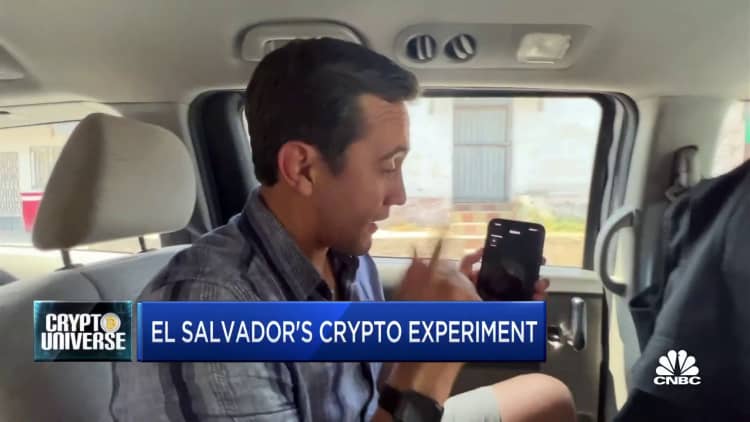 ‘Sleepwalking into a debt default’Well before Bukele wagered that bitcoin would bandage over longstanding economic vulnerabilities, the country was in a lot of trouble.The World Bank projects that the Salvadoran economy will grow by 2.9% this year and 1.9% in 2023, down from 10.7% in 2021. But that growth itself was a bounce-back from an 8.6% contraction in 2020.Its debt-to-GDP ratio is almost 90%, and its debt is expensive at around 5% per year versus 1.5% in the U.S. The country also has a massive deficit — with no plans to reduce it, whether through tax hikes or by substantially cutting spending.In a research note from JPMorgan, analysts warn that El Salvador’s eurobonds have entered “distressed territory” in the last year, and S&P Global data reportedly shows that the cost to insure against a sovereign debt default is hitting multiyear highs.Both JPMorgan and the International Monetary Fund warn the country is on an unsustainable path, with gross financing needs set to surpass 15% of GDP from 2022 forward — and public debt on track to hit 96% of GDP by 2026 under current policies.El Salvador faces a heavy mix of multilateral and domestic debts, including imminent debt repayment deadlines in the billions of dollars, such as an $800 million eurobond that matures in January.”The domestic debt is very large, relatively short duration and needs to be rolled over frequently,” said Muci, who previously worked at the Growth Lab at the Harvard Kennedy School of Government.El Salvador has been trying since early 2021 to secure a $1.3 billion loan from the IMF — an effort that appears to have soured over Bukele’s refusal to heed the organization’s advice to ditch bitcoin as legal tender.Rating agencies, including Fitch, have knocked down El Salvador’s credit score, citing the uncertainty of the country’s financial future given the adoption of bitcoin as legal tender. That means that it’s now even more expensive for Bukele to borrow much-needed cash.Beyond the fact that global lenders don’t want to throw money at a country that is spending millions in tax dollars on a cryptocurrency whose price is prone to extreme volatility, the IMF’s largest shareholder, the U.S., is targeting Salvadoran officials as part of wider international sanctions against “corrupt actors.”The president’s efforts to consolidate power have also driven up this risk premium for global lenders.Bukele’s New Ideas party has control over the country’s Legislative Assembly. In 2021, the new assembly came under fire after it ousted the attorney general and top judges. The move prompted the U.S. Agency for International Development to pull aid from El Salvador’s national police and a public information institute and reroute the funds to civil society groups.Additionally, El Salvador can’t print cash to shore up its finances. El Salvador ditched its local currency, the colon, in favor of the U.S. dollar. Only the Federal Reserve can print more dollars. Meanwhile, its other national currency, bitcoin, is revered for the fact that it, too, is impossible to mint out of thin air.”One of the big issues has been the fact that the bitcoin gimmick has distracted from the fiscal and economic challenges of the country and made it more difficult for the country to access IFI lending and preferential terms,” Ziemba said.Ziemba added that there have been some swaps with major crypto firms that allowed the country to raise cash to pay off the debt due this year, and perhaps early next year, but the long-term debt sustainability remains a challenge.”They’ve spooked the bejesus out of financial markets and the IMF,” said Muci, who tells CNBC that nobody wants to lend money to Bukele unless it’s at “eye-gouging rates” of 20% to 25%.”The country is sleepwalking into a debt default,” Muci said.
‘Sleepwalking into a debt default’Well before Bukele wagered that bitcoin would bandage over longstanding economic vulnerabilities, the country was in a lot of trouble.The World Bank projects that the Salvadoran economy will grow by 2.9% this year and 1.9% in 2023, down from 10.7% in 2021. But that growth itself was a bounce-back from an 8.6% contraction in 2020.Its debt-to-GDP ratio is almost 90%, and its debt is expensive at around 5% per year versus 1.5% in the U.S. The country also has a massive deficit — with no plans to reduce it, whether through tax hikes or by substantially cutting spending.In a research note from JPMorgan, analysts warn that El Salvador’s eurobonds have entered “distressed territory” in the last year, and S&P Global data reportedly shows that the cost to insure against a sovereign debt default is hitting multiyear highs.Both JPMorgan and the International Monetary Fund warn the country is on an unsustainable path, with gross financing needs set to surpass 15% of GDP from 2022 forward — and public debt on track to hit 96% of GDP by 2026 under current policies.El Salvador faces a heavy mix of multilateral and domestic debts, including imminent debt repayment deadlines in the billions of dollars, such as an $800 million eurobond that matures in January.”The domestic debt is very large, relatively short duration and needs to be rolled over frequently,” said Muci, who previously worked at the Growth Lab at the Harvard Kennedy School of Government.El Salvador has been trying since early 2021 to secure a $1.3 billion loan from the IMF — an effort that appears to have soured over Bukele’s refusal to heed the organization’s advice to ditch bitcoin as legal tender.Rating agencies, including Fitch, have knocked down El Salvador’s credit score, citing the uncertainty of the country’s financial future given the adoption of bitcoin as legal tender. That means that it’s now even more expensive for Bukele to borrow much-needed cash.Beyond the fact that global lenders don’t want to throw money at a country that is spending millions in tax dollars on a cryptocurrency whose price is prone to extreme volatility, the IMF’s largest shareholder, the U.S., is targeting Salvadoran officials as part of wider international sanctions against “corrupt actors.”The president’s efforts to consolidate power have also driven up this risk premium for global lenders.Bukele’s New Ideas party has control over the country’s Legislative Assembly. In 2021, the new assembly came under fire after it ousted the attorney general and top judges. The move prompted the U.S. Agency for International Development to pull aid from El Salvador’s national police and a public information institute and reroute the funds to civil society groups.Additionally, El Salvador can’t print cash to shore up its finances. El Salvador ditched its local currency, the colon, in favor of the U.S. dollar. Only the Federal Reserve can print more dollars. Meanwhile, its other national currency, bitcoin, is revered for the fact that it, too, is impossible to mint out of thin air.”One of the big issues has been the fact that the bitcoin gimmick has distracted from the fiscal and economic challenges of the country and made it more difficult for the country to access IFI lending and preferential terms,” Ziemba said.Ziemba added that there have been some swaps with major crypto firms that allowed the country to raise cash to pay off the debt due this year, and perhaps early next year, but the long-term debt sustainability remains a challenge.”They’ve spooked the bejesus out of financial markets and the IMF,” said Muci, who tells CNBC that nobody wants to lend money to Bukele unless it’s at “eye-gouging rates” of 20% to 25%.”The country is sleepwalking into a debt default,” Muci said.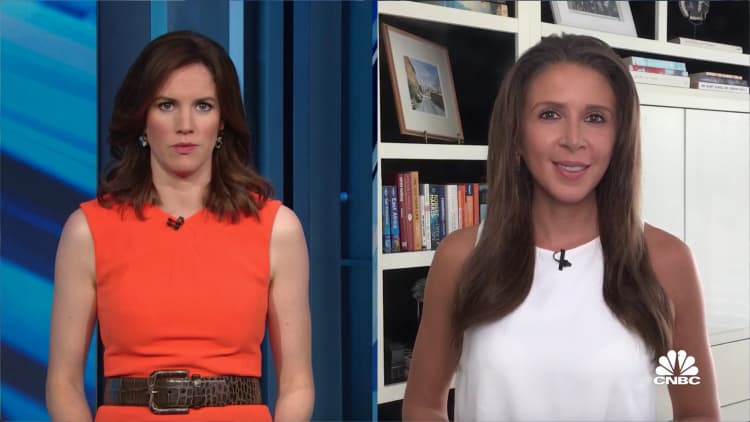 Tourism and presidential popularity solidOn the day the Bitcoin Law took effect, Bukele revealed that the country had begun to add bitcoin to government coffers. Since then, the price of the cryptocurrency has plunged more than 60%, stoked by rising interest rates and failed projects and bankruptcies in the industry.The government has an unrealized paper loss on bitcoin of around $60 million. None of these losses are locked in until the country exits its bitcoin position.In aggregate, the entire experiment and all its associated costs have only set the government back around $375 million, according to estimates. That’s not nothing — especially considering the fact that El Salvador has $7.7 billion of bonds outstanding — but to an economy of $29 billion, it is comparatively small.El Salvador’s millennial, tech-savvy president — who once touted himself as the “world’s coolest dictator” on his Twitter bio — has tethered his political fate to the country’s crypto gamble, so he has a very big incentive to make it work in the long run and to pay off the country’s debt in the interim. Bukele faces reelection for another five-year presidential term in 2024.At least El Salvador’s big bitcoin gamble has been a win in terms of attracting bitcoin tourists.The tourism industry is up 30% since the Bitcoin Law took effect, according to official government estimates. The country’s tourism minister also notes that 60% of tourists now come from the U.S.The bitcoin experiment hasn’t hurt the president’s popularity either. Bukele’s approval ratings are north of 85% — thanks in large part to his tough-on-crime approach to leading. That’s no small thing to a country that was more dangerous per capita than Afghanistan five years ago.Suter said the project has also introduced many locals to the concept of savings, noting that before the Bitcoin Law, much of the population didn’t have a way to digitally hold their money and transact among one another.”It was all cash — and the cash that you earned that week, you typically spent it, because there wasn’t much ability to dream of growing it through investment.”
Tourism and presidential popularity solidOn the day the Bitcoin Law took effect, Bukele revealed that the country had begun to add bitcoin to government coffers. Since then, the price of the cryptocurrency has plunged more than 60%, stoked by rising interest rates and failed projects and bankruptcies in the industry.The government has an unrealized paper loss on bitcoin of around $60 million. None of these losses are locked in until the country exits its bitcoin position.In aggregate, the entire experiment and all its associated costs have only set the government back around $375 million, according to estimates. That’s not nothing — especially considering the fact that El Salvador has $7.7 billion of bonds outstanding — but to an economy of $29 billion, it is comparatively small.El Salvador’s millennial, tech-savvy president — who once touted himself as the “world’s coolest dictator” on his Twitter bio — has tethered his political fate to the country’s crypto gamble, so he has a very big incentive to make it work in the long run and to pay off the country’s debt in the interim. Bukele faces reelection for another five-year presidential term in 2024.At least El Salvador’s big bitcoin gamble has been a win in terms of attracting bitcoin tourists.The tourism industry is up 30% since the Bitcoin Law took effect, according to official government estimates. The country’s tourism minister also notes that 60% of tourists now come from the U.S.The bitcoin experiment hasn’t hurt the president’s popularity either. Bukele’s approval ratings are north of 85% — thanks in large part to his tough-on-crime approach to leading. That’s no small thing to a country that was more dangerous per capita than Afghanistan five years ago.Suter said the project has also introduced many locals to the concept of savings, noting that before the Bitcoin Law, much of the population didn’t have a way to digitally hold their money and transact among one another.”It was all cash — and the cash that you earned that week, you typically spent it, because there wasn’t much ability to dream of growing it through investment.”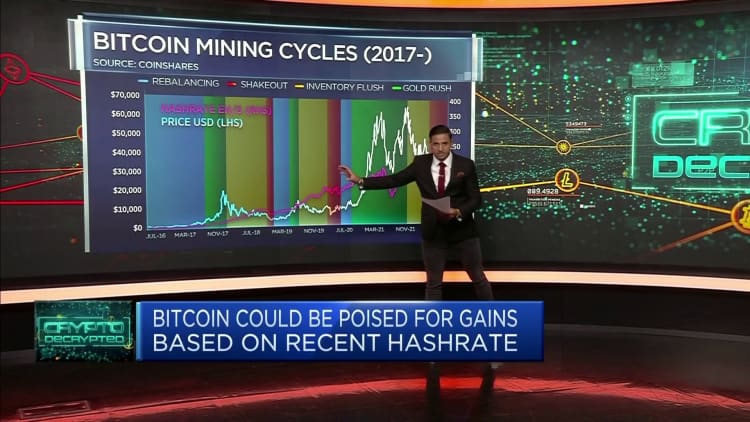 The president upped the ante in November when he announced plans to build a “Bitcoin City” next door to the Conchagua volcano in southeastern El Salvador. The bitcoin-funded city would offer significant tax relief, and geothermal energy rolling off the adjacent volcano would power bitcoin miners.But now, Bitcoin City is on hold, as is the $1 billion bitcoin bond sale, which was initially put on ice in March because of unfavorable market conditions.”Ultimately, El Salvador’s problems are just tangential to currency,” Muci said.”The plane is gonna crash eventually, if they don’t change things,” he said — “if they don’t raise taxes, cut spending, start being much more disciplined, convincing markets that they’re sustainable.””Bitcoin doesn’t solve any of El Salvador’s important economic problems,” he added.
The president upped the ante in November when he announced plans to build a “Bitcoin City” next door to the Conchagua volcano in southeastern El Salvador. The bitcoin-funded city would offer significant tax relief, and geothermal energy rolling off the adjacent volcano would power bitcoin miners.But now, Bitcoin City is on hold, as is the $1 billion bitcoin bond sale, which was initially put on ice in March because of unfavorable market conditions.”Ultimately, El Salvador’s problems are just tangential to currency,” Muci said.”The plane is gonna crash eventually, if they don’t change things,” he said — “if they don’t raise taxes, cut spending, start being much more disciplined, convincing markets that they’re sustainable.””Bitcoin doesn’t solve any of El Salvador’s important economic problems,” he added.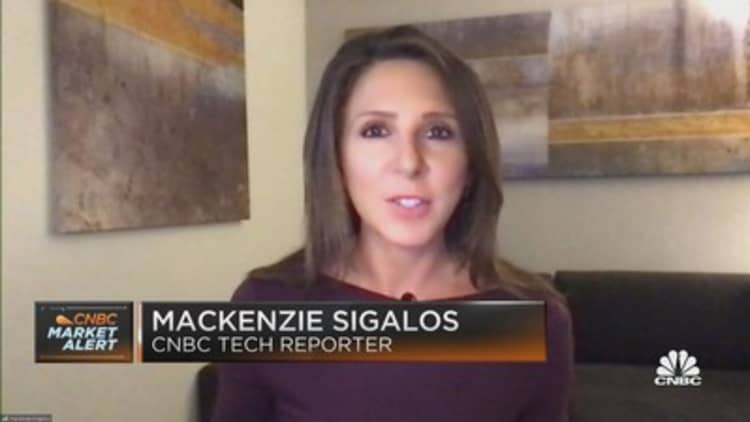 .
.
CEO Behind $50 Billion Stablecoin Explains Why Not All Digital Dollars Are Created Equal
Circle CEO Jeremy Allaire
Circle Financial
Jeremy Allaire is CEO of Circle, one of the primary issuers of the dollar-pegged USD Coin, one of the fastest growing stablecoins in the world. With a market cap north of $50 billion, USDC is closing in on the massive lead that Tether has long held. However, Circle is much more than just the issuer of a stablecoin. The company is using the token to build an entire financial ecosystem on top of multiple blockchains and offer simple tools for businesses to integrate USDC into their operations.
In an exclusive interview with Forbes, Allaire breaks down how stable coins are becoming integrated into the traditional financial system and to get a sense of how Circle is handling the added scrutiny that the entire industry is facing as a result of the Russia/Ukraine crisis. Additionally, Circle is back on the SPAC path again, reaching a new deal to go public with a $9 billion valuation.
This interview is excerpted from our premium research publication Forbes CryptoAsset and Blockchain Advisor. Subscribe today for more breaking news, exclusive insights, interviews and more.
Forbes: Can you give us a short overview of Circle’s main lines of business?
Jeremy Allaire: The most foundational part of the business is what we call our stablecoin market infrastructure business, which is best understood as the USDC product. We think about that as market infrastructure that is made available to any kind of market participant to integrate with and to use. It’s something that end users and developers and people building products and services can just integrate into their products. So unlike, say, a traditional business where everyone is a direct customer, we operate both a protocol and a digital currency. The goal is to get as many developers as possible, integrating with it as many apps and services connecting to it. By doing that, it increases the utility of the protocol. We have many types of partnerships that are aimed at getting greater use and distribution, the biggest of which is Coinbase, a launch partner of USDC. Coinbase makes it really accessible to the average retail end user. But now, with partnerships with firms like FTX, and NFT firms and DeFi protocols, it’s available in a lot of different ways. There is about $53 billion worth of USD Coin (USDC) in circulation, which on an equivalent basis would make us one of the 50 biggest banks in the U.S.
The next big piece is what we call our transaction services business. Maybe before even getting into that, at the core, we offer something called Circle Account, a free account available to businesses of all sizes that provides a way for people to connect banking, store and hold USDC, and convert and redeem it across multiple blockchains. With the free account, there’s also additional value-added products that we charge for. Our Treasury Services Product is our lending product, where a business can come in and they can lend us USDC. Or if they have dollars, they can convert into USDC, and then lend that USDC on a fixed term, like one month, three months, six months, 12 months or fixed rate, that turn and then we do wholesale lending behind that, and we pay interest on those USDC loans.
Forbes: How is the relationship between Circle and USDC similar or different to Ripple and XRP?
Allaire: A digital currency like USDC is very, very different. USDC is a stored-value payment instrument regulated by banking supervisors throughout the U.S. It has been since day one roughly four years ago in 2018. It’s the same regulations that regulate PayPal and Square Cash, and Apple Pay and Venmo. With all these, when you put dollars in, you get a 1:1 digital representation that you can then use in a digital application. We just happened to be issuing the stored value digital assets on blockchains instead of a closed loop, walled garden thing, like Venmo. We didn’t go and sell a token. There’s not someone who speculates on the value of USDC and it’s not used to pay for use of a blockchain. So, it’s very different from what I think of as native tokens of blockchains that are used for paying fees on a blockchain like ether, XRP monero or solana, or any of these tokens that are used for operating on a blockchain. We just sit on top; we’re like a layer above the blockchains.
Forbes: Let’s talk about USDC’s reserves. Recently you’ve changed the constitution to focus on cash and short-term government debt rather than commercial debt, etc. What was the thought process behind this change? Also, do you expect to go back to holding more short-term commercial debt and other types of assets based on a risk management profile that you’ve set up?
Allaire: Over the last year the market and regulators have looked at this space more closely and said, “Hey, this is growing really fast. This has the potential to be systemically scaled, and we want to make sure that stable value digital currencies are the safest possible for general use as a cash equivalent instrument.” Given the market and regulator demand, we made the change and have had a tremendous response. I think the interesting question embedded in your question is what does the future look like? I think that’s a policy question. And that is at the heart of the policy work that’s happening with the U.S. Treasury Department, Congress and in other places, which is what statutes are going to come into place for federally chartered and licensed stablecoin banks like Circle—we’re in the process of preparing to apply for a national bank charter. What’s important is that a stablecoin issuer is a full reserve bank. When you think about a traditional bank, if you have a Chase account, for example, you don’t actually have dollars, you have Chase dollars. Those are IOUs; you have a liability from Chase. If you have $1,000 in your bank account or checking account, you don’t actually have $1,000, you have a claim on $1,000. You really are effectively holding a lending book. That’s what we all know of as fractional reserve banking—they lend out the money eight times, ten times, and hopefully not everyone comes at once and wants their money back. But in case they do, there are all kinds of parameters put around the bank, what kind of assets they’re allowed to hold, and they have stress tests for things like what if there’s huge outflows over a 30-day period? Stablecoins right now are a lot simpler. You’ve got government, Treasuries and cash. And you’re not lending it out to anyone. There is no run risk in that sense. So, you don’t need FDIC insurance, because FDIC insurance was designed for fractional reserve banks. But you might want to have rules around what you are allowed to do with the reserves—risk perimeters—and here’s what we expect from you in terms of liquidity and meeting those liquidity requirements. That set of rules, the assets and the liquidity, and the risk management for stable value digital currencies, those have to get written. That form of bank charter has never existed and needs to get written. So that’s what we’re working towards.
Forbes: You recently testified in front of Congress. I’d love to get some of your key takeaways from that experience. Additionally, any insight on recent conversations coming out of the SEC, like the suggestion that stablecoins could be securities or on the implications that BlockFi’s $100 million settlement could have on your lending business? Coinbase, your partner, had publicly challenged the SEC regarding a lending product based on USDC, which it ended up not launching.
Allaire: I think it’s very clear and we’ve heard Chair Gensler make multiple statements that a cash equivalent regulated under the payments law/banking law model is not a security. I could imagine arguments being made about other stablecoins that are maybe synthetic in nature could be synthetic derivatives, or other stablecoins that are actively managing an investment portfolio that includes long running risk and other things could be looked at and treated differently because that’s operating outside of the stored value. We’ve always stayed defined in that payment system law. Lending products that are built using something like USDC, where a person is lending USD Coin and getting paid an interest rate on it is an investment contract. And if you’re not a bank and you’re offering that then you’re offering a security. That has always been our view and that’s why when we launched Circle Yield, which is a lending product where you lend USDC and you’re paid an interest rate, you’re purchasing a security, and that exempt security is filed with the SEC. We have risk disclosures, and we only make that product available to accredited investors and businesses.
Forbes: Let’s turn to the Russia/Ukraine crisis. Have you noticed any illicit use of USDC to evade sanctions or launder money.
Allaire: No, but I think there’s a couple things I can say. First, Circle has always run very strong compliance programs. We’ve been registered with FinCEN since 2014. We have scaled compliance programs, sanctions enforcement programs, and worked very closely with law enforcement to monitor and block any sanctioned entities or blockchain addresses. We also run our own deeper forms of analysis and detection. We work with networks of other exchanges, wallets and others on that as well. We have also seen a significant amount of USDC used in aid to Ukraine. We’ve launched our own programs around that as well, partnering with organizations that are able to do entity verification, organization verification, things like that. So that’s been really key. Because we don’t face the retail market directly ourselves. It’s not like we have account holders in Russia or things like that.
Forbes: What does it mean to block an address with USDC and does that impact any perceived notions of decentralization?
Allaire: We have a strict blacklisting policy, which is effectively if there is a fundamental risk to the integrity and security of USDC itself, Centre reserves the right to blacklist that address. That would be something like a system attack or if a binding court order is presented to Centre we can blacklist an address. This is not, “I sent stuff to the wrong address or a DeFi protocol got hacked, can you give me back my money?” There’s a huge moral hazard with that. And so it is really about law enforcement.
Regarding centralization concerns, Circle is a regulated financial institution that requires that certain controls are put in place. We have a hybrid model of operating on decentralized infrastructure. But there’s a centralized issuer, and that’s a feature for a lot of people even if it might be a bug to others. If you look specifically at the history here, there are an extraordinarily limited number of instances where this has happened.
Forbes: Can you walk me through the initial rationale for the SPAC and explain why it’s been delayed?
Allaire: Last spring, we made a decision to enter the public markets as a firm. There are lots of different reasons to become a public company. For us it falls into a few categories. First, it’s an opportunity to access the capital markets, raise capital, etc. Second, as a kind of financial market infrastructure, our belief is that being a public company and having the incremental regulatory requirements, which are very significant, is a really important signal to the market. Third, the special purpose acquisition company (SPAC) model offers a lot of attractive qualities to an entrepreneur, such as time to market. For a long while, the time to market on a public listing through a SPAC was three to five months instead of six to 12 months. That changed as SPACs received more scrutiny, especially some of the problematic ones. I think another challenge was simply that we are a fairly novel company with a fairly novel business in an area where there are core accounting risk regulatory questions, and the SEC is doing its job to ensure the right level of disclosure, risk accounting, regulatory, etc. Getting through SEC qualification is taking longer, which is fine. My view is that we’re going back and forth, we’re iterating through and will ultimately get through qualification and be a listed company, but it’s taking a bit longer than we had originally expected.
Forbes: With the amount of money being thrown around in private markets, did you ever think of holding off on going public? Why did your valuation now double to $9 billion?
Allaire: We are totally committed to being a public company. And given the significantly improved financial outlook for the next couple of years, we felt that the value of our company had clearly gone up. So, we revised the deal.
Forbes: When the deal was first announced, I was surprised to see that your Treasury and Transaction Services business brought in more revenue than interest on USDC holdings. According to some of your recent projections, you expect that trend to dramatically reverse. What led to this new outlook?
Allaire: A couple of things. USDC is continuing to grow rapidly and we are in a rising rate environment. These rising rates accrue directly to our income stream and our revenue. That’s reflected in the revision. Since the start of the year, we have added another $10 or $11 billion. Additionally, as we look forward, we’re seeing a lot of growth in the kinds of use cases where USDC is coming into play. And I think for us thematically, we’re seeing more and more traditional payments companies wanting to start using USDC. We’re seeing emerging interest from internet commerce use cases, which is exciting to see now that we can do fast, cheap, nearly instant USDC payments. And we’re starting to see interest from traditional finance (TradFi) looking at this as an improved way to do digital cash dollar settlement type stuff. So, I think it ties into a little bit of our business outlook for the next couple of years.
Forbes: Thank you.
.

